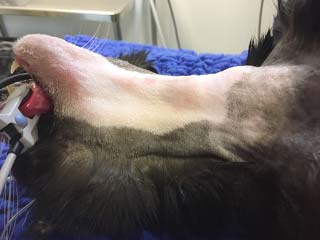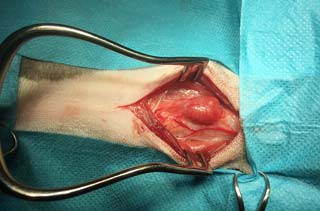6 Feb 2017
Kerry Simpson following part 1 based on diagnosis (VT47.03), suggests a selection of therapies and treatments for this condition.

Figures 1b. Surgical removal of the thyroid glands.
It is recognised, in many countries, hyperthyroidism is the most common endocrinopathy seen in cats. As it is typically caused by hyperplasia of the thyroid gland, with only 1% to 2% of cases being caused by a thyroid carcinoma (Gerber et al, 1994; Edinboro et al, 2004; Peterson, 2012), hyperthyroidism is a largely treatable disorder that, without therapy, can prove fatal in cats.
Options for treatment include oral/transdermal antithyroidal medication (such as thiamazole, methimazole and carbimazole), surgery, radioactive iodine therapy or feeding an iodine-deplete diet. The choice of treatment depends largely on factors such as the cat’s temperament, age, comorbidities, the availability and cost of treatments, and the clinician’s experience. Some cats will require concurrent medications, most frequently to correct the associated heart disease, hypertension or renal disease (Feldman and Nelson, 2004).
If a hyperthyroid cat is relatively young or not suffering from significant comorbidities then definitive treatment is generally recommended. In many cases, pretreatment with medical therapy to restore euthyroidism is recommended (Daminet et al, 2014; Carney et al, 2016).

Experts are generally in agreement radioactive iodine therapy is the treatment of choice in the uncomplicated hyperthyroid cat (Carney et al, 2016). Treatment involves the administration of iodine-131 (I-131) SC, followed by a period of isolation. Iodine is taken up almost exclusively by the thyroid gland and, therefore, the radioactive isotope is concentrated in the gland.
I-131 emits both beta and gamma particles. However, it is the beta particles that are responsible for the majority of the tissue destruction. As these particles penetrate 1mm to 2mm, only hyperactive cells, and those in the immediate vicinity, are destroyed, with no significant damage to the parathyroid glands or atrophic thyroid tissue.
Radioactive iodine therapy has many advantages as it will destroy hyperplastic/adenomatous cells in any location and has a cure rate of around 95% – cats with thyroid carcinoma will not respond to normal dose I-131, but can be treated successfully with a high dose protocol – and has a low relapse rate of approximately 5%, with the majority of non-responders or cats that relapse responding to second treatment.
A minimal risk of hypothyroidism exists with standard dosing protocols and serious side effects, such as thyroid storm, are rare. However, I-131 therapy requires specialised facilities, which are not widely available and, at present, have markedly differing hospitalisation and confinement periods (ranging from 5 days to 28 days in the UK). Facilities that offer quicker discharge will have caveats dictating the cat must remain indoors (usually for a further two weeks), not sleep on the owners bed at night, and waste must be flushed down the toilet or put into household bins. However, for many this is an attractive option. The overall cost is generally lower than the long-term cost of either medical or dietary therapy, and the long-term outlook is generally excellent.
Another definitive option is surgical removal of the thyroid glands (Figures 1a and 1b). Practitioners may take several approaches, including bilateral thyroidectomy with an intracapsular, or extracapsular, technique, unilateral thyroidectomy (only appropriate for true unilateral disease) and staged bilateral thyroidectomy. However, surgery and anaesthesia can be associated with increased morbidity and mortality, and, depending on the surgical method used, postoperative hypocalcaemia can occur in up to 82% of cases (Scott-Moncreiff, 2015). Often, this is mild and/or transient and, in such cases, treatment might not be necessary; however, severe cases require treatment that may be short to medium term or, at times, permanent.
Other surgical complications include laryngeal paralysis, voice/purr change, Horner’s syndrome, clinical hypothyroidism and recurrence of disease state – reported in up to 10% of cats post-bilateral thyroidectomy and up to 65% of cases where unilateral thyroidectomy is performed. It is reported 4% to 9% of cats have ectopic adenomatous thyroid tissue (sublingual or intrathoracic), which is unlikely to be removed during routine thyroidectomy (Peterson et al, 2012; Carney et al, 2016).
Antithyroid medications (methimazole, thiamazole or carbimazole) can be used for the short-term stabilisation of cases prior to surgical intervention or I-131 therapy, to assess the response to therapy, such as whether the cat will develop significant azotaemia with treatment, or for the long-term management of feline hyperthyroidism.
Within the body, carbimazole is metabolised to methimazole with an availability of approximately 5:3, such as 5mg of carbimazole becomes 3mg of methimazole. Methimazole then inhibits the biosynthesis of thyroid peroxidase and, therefore, the formation of thyroid hormones. Carbimazole and methimazole are available in tablet form – methimazole as a twice-daily medication, and carbimazole as a once-daily, slow-release preparation. In addition, methimazole is also available as a transdermal or liquid preparation.
Studies directly comparing these medications have not been published; however, one questionnaire study assessing owner’s opinions on the treatment of their hyperthyroid cat documented once daily treatment was not considered the most important factor in the treatment of his or her cat’s disease (Caney, 2013). In general, studies investigating transdermal preparations demonstrate a higher starting dose may be required to compensate for slow absorption (Hill et al, 2014; Carney et al, 2016).

When choosing an antithyroid medication, the clinician should discuss with the owner the temperament of the cat, exposure of other cats within the household, such as allogrooming of transdermal products, and the cost of treatment and follow-up monitoring. While, medical management is a more cost-effective option in the short term, long-term medications and monitoring ultimately make medical therapy less cost effective than definitive treatment (Carney et al, 2016).
Most cats treated with antithyroidal medications are euthyroid within two to three weeks of starting treatment (Daminet et al, 2014, Carney et al, 2016). However, the requirement of different individuals varies quite markedly and many cats will need dose adjustments within the first few weeks of treatment (Daminet et al, 2014).
One study has demonstrated cats treated with long-term medical management did not have a total thyroxine (T4) significantly different to untreated hyperthyroid cats (Simpson, 2005). This emphasises the importance of continuous follow-up, with dose adjustments as the disease progresses. In addition, one author has hypothesised long-term medical treatment may predispose to the development of thyroid carcinoma (Peterson et al, 2016).
Antithyroid drugs are not without side effects. Typically, these are seen within the first 3 to 6 weeks of treatment and are reported in up to 25% of cats (Daminet et al, 2014). A wide range of side effects were reported, including facial pruritus, vomiting, liver failure, blood dyscrasias and bleeding disorders (Carney et al, 2016). It should be noted, if a cat demonstrates a hypersensitivity reaction to one thyroid medication, such as carbimazole, it will also demonstrate hypersensitivity to methimazole as the active metabolite is the same (Daminet et al, 2014).
Iodine is required for the production of the thyroid hormones. Therefore, restricting the iodine uptake of the cat can lead to a decrease in the concentration of thyroid hormones. This realisation led to the development of a restricted-iodine diet for the treatment of hyperthyroidism in the cat.
It has been reported, with good compliance, 75% of cats will demonstrate a significantly reduced thyroxine and less clinical signs within 28 days of receiving the diet, although it may take significantly longer (up to 180 days) in cats with severely elevated T4, and some cats will not respond to treatment (van der Kooij et al, 2014).
Before considering dietary control, the clinician should ascertain whether the cat is a suitable candidate. Cats being fed an iodine-deplete diet cannot receive any other foods or medications that contain iodine; they should be indoor-only cats, other medications should be investigated for the inclusion of iodine, they should not have comorbidities that warrant a different diet and they should not be able to access the food of any other cats in the household.
If all of these criteria can be fulfilled and the cat finds the diet palatable then dietary management may be appropriate. However, it should be noted long-term studies assessing the effect of dietary regulation have not been performed.
A common concern in the treatment of hyperthyroid cats is “unmasking renal disease”. Studies suggest treatment of hyperthyroidism, but avoiding hypothyroidism, is advantageous in cats with renal insufficiency and it is deleterious to aim to keep cats slightly hyperthyroid to “increase renal perfusion”, as this approach can worsen renal disease by increasing the beta-adrenergic activity and the activity of the renin-angiotensin-aldosterone system, leading to volume overload, renal hypertension and glomerular sclerosis, thereby worsening chronic kidney disease (CKD; Carney et al, 2016).
The American Association of Feline Practitioners guidelines on the treatment of hyperthyroidism recommends the treatment of hyperthyroidism regardless of concurrent disease, including cats with pre-existing CKD and those that develop CKD after initiation of anti-thyroid treatment (Carney et al, 2016).
However, the treatment recommendations differ based on the severity of the renal insufficiency. Cats with IRIS stage I or II require little to no additional treatment, although monitoring for urinary tract infections (common in both CKD and hyperthyroid cats), proteinuria and hypertension should be performed regularly. However, cats with IRIS stage III or IV disease may require a more prudent approach with management of their CKD alongside gradual stabilisation of their thyroid disease, ideally using a reversible medical therapy, and taking care to avoid over treatment, as hypothyroidism has been linked to azotaemia and shortened survival times in cats.
Another important comorbidity is cardiac disease. The thyroid hormones have a direct effect on the heart. Triiodothyronine has also been shown to increase the number of β1-adrenergic receptors and alters the ratio of V1:V3 myosin, the activity of calcium adenosine triphosphatase (Ca2+-ATPase), and with these (among other) alterations the heart rate, strength of contraction and relaxation.
It is well documented cats can suffer thyrotoxic cardiomyopathy, which may require additional medications. However, in many the cardiac changes will resolve with successful treatment of the hyperthyroidism.
In one study, cats with hyperthyroidism were found to have elevated N-terminal pro-brain natriureic peptide and, in the majority, this decreased within three months of achieving euthyroidism (Menaut et al, 2012). If cats do not have resolution of their heart disease, investigations should be undertaken to ascertain whether there is an underlying heart condition, such as hypertrophic cardiomyopathy or hypertensive cardiac disease.
Hypertension is common in hyperthryoid cats. However, rather than being at increased risk at the time of diagnosis, studies have demonstrated the risk of developing hypertension is highest after successful treatment of the disease (Williams et al, 2010a; 2010b). Therefore, it is recommended hyperthyroid cats have their blood pressure assessed not only at diagnosis, but at regular (one to three months) intervals after treatment.
In addition, it is prudent to assess the urinalysis at these time points as hyperthyroid cats are at an increased risk of clinically silent urinary tract infections (UTI) and proteinuria (in association with CKD, hypertension or UTI). It has been demonstrated renal proteinuria (such as that found in association with hypertension or CKD) is a negative prognostic indicator.
Hyperthyroidism is becoming increasingly common in cats – it is recognised in elderly cats that are eating more, losing weight and may appear more playful. Diagnosis is straightforward in the majority of cases, but some cats will not demonstrate typical changes and can be challenging to diagnose.
Once a diagnosis is made, the treatment options should be discussed at length, with the advantages and disadvantages of each option highlighted, considering which will be best for the individual in the long term. If significant concomitant diseases are present then it is generally advisable to trial medical or dietary therapy prior to considering a permanent treatment.
No matter what treatment option is selected, the cat will require regular check-ups; if diet or medical therapy is selected this will include blood sampling, blood pressure and urinalysis, whereas if either surgery or I-131 is selected, regular blood pressure checks are advised.